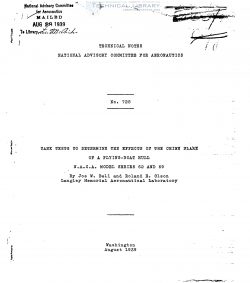naca-tn-725
- Version
- 132 Downloads
- 1.31 MB File Size
- 1 File Count
- November 30, 2016 Create Date
- November 30, 2016 Last Updated
National Advisory Committee for Aeronautics, Technical Notes - Tank Tests to Determine the Effects of the Chine Flare of a Flying Boat Hull

Twenty-two models of flying-boat hulls were tested
in the N.A.C.A. tank for the purpose of determining the
effects on water resistance and spray of 13 Variations in
the transverse section of the bottom of the forebody and
of three variations in the form of the afterbody. The
forebodies were of the same over—all dimensions and dif-
fered in the type and amount of chine flare. The after—
bodies included one with a pointed plan form and straight
buttocks, one with a second step and straight buttocks,
and one with a second step and concave buttocks. The
depth of the step at the keel was the Same in all models.
In general, the effect of chine flare on the resist-
ance was small although, at speeds Just above the hump,
the resistance of forms with chine flare was generally
less than the resistance of the form without chine flare.
The chine flare reduced the height of the forward part of
the spray where the spray leaves the chine of the model
above the water level but had little effect on the spray
where the chine of the model was below the-water level.
In cases of extreme flare, the spray forming Just ahead
of the step seemed to be higher.
It was concluded that model 62—AD, consisting of a f
forebody with a chine flare having a width of 0.083 beam
and 5° angle, combined with an afterbody having a second
transverse step and concave buttocks, was the best of the
combinations tested. Charts for the determination of the
resistance and the static properties of this model are
given.
Most seaplane hulls are built with transverse curva-
ture in the sides of the V—bottom to reduce the height of
the spray. In some hulls, the curvature extends from the
keel to the chine and, in others, the curvature is in only
the outer portions of the transverse sections. Curvature
in only the outer portions is known as chine flare. The
selection of the type of curvature for the transverse sec-
tions involves a compromise in which the designer must de—
cide between a complex form of hull with controlled spray
and a simple form with unsupprossed spray and, in general,
must consider possible effects of the hydrodynamic forces
on the hull. This selection of transverse sections has,
in many cases, been made by intuition and has led to a
wide variety of transverse section
| File | Action |
|---|---|
| naca-tn-725 Tank Tests to Determine the Effects of the Chine Flare of a Flying Boat Hull.pdf | Download |

Comment On This Post